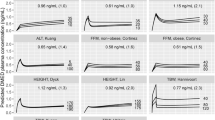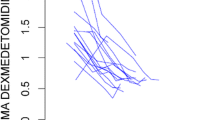Abstract
Purpose
Dexmedetomidine is an α2-adrenoceptor agonist used for perioperative and intensive care sedation. This study develops mechanism-based population pharmacokinetic-pharmacodynamic models for the cardiovascular and central nervous system (CNS) effects of intravenously (IV) and intranasally (IN) administered dexmedetomidine in healthy subjects.
Method
Single doses of 84 μg of dexmedetomidine were given once IV and once IN to six healthy men. Plasma dexmedetomidine concentrations were measured for 10 h along with plasma concentrations of norepinephrine (NE) and epinephrine (E). Blood pressure, heart rate, and CNS drug effects (three visual analog scales and bispectral index) were monitored to assess the pharmacological effects of dexmedetomidine. PK-PD modeling was performed for recently published data (Eur J Clin Pharmacol 67: 825, 2011).
Results
Pharmacokinetic profiles for both IV and IN doses of dexmedetomidine were well fitted using a two-compartment PK model. Intranasal bioavailability was 82 %. Dexmedetomidine inhibited the release of NE and E to induce their decline in blood. This decrease in NE was captured with an indirect response model. The concentrations of the mediator NE served via a biophase/transduction step and nonlinear pharmacologic functions to produce reductions in blood pressure and heart rate, while a direct effect model was used for the CNS effects.
Conclusion
The comprehensive panel of two biomarkers and seven response measures were well captured by the population PK/PD models. The subjects were more sensitive to the CNS (lower EC 50 values) than cardiovascular effects of dexmedetomidine.






Similar content being viewed by others
References
Chrysoslomou C, Schmitt GG (2008) Dexmedetomidine: sedation, analgesia and beyond. Expert Opin Drug Metab Toxicol 4:619–627
Limbird LE (1988) Receptors linked to inhibition of adenylate cyclase: additional signaling mechanisms. FASEB J 2:2686–2695
Brede M, Philipp M, Knaus A, Muthig V, Hein L (2004) Alpha2-adrenergic receptor subtypes - novel functions uncovered in gene-targeted mouse models. Biol Cell 96:343–348
Belleville JP, Ward DS, Bloor BC, Maze M (1992) Effects of intravenous dexmedetomidine in humans. I. Sedation, ventilation, and metabolic rate. Anesthesiology 77:1125–1133
Hsu YW, Cortinez LI, Robertson KM, Keifer JC, Sum-Ping ST, Moretti EW, Young CC, Wright DR, Macleod DB, Somma J (2004) Dexmedetomidine pharmacodynamics: part I: crossover comparison of the respiratory effects of dexmedetomidine and remifentanil in healthy volunteers. Anesthesiology 101:1066–1076
Bekker A, Sturaitis MK (2005) Dexmedetomidine for neurological surgery. Neurosurgery 57(1 Suppl):1–10, discussion 11–10
Bloor BC, Ward DS, Belleville JP, Maze M (1992) Effects of intravenous dexmedetomidine in humans. II. Hemodynamic changes. Anesthesiology 77:1134–1142
Dyck JB, Maze M, Haack C, Vuorilehto L, Shafer SL (1993) The pharmacokinetics and hemodynamic effects of intravenous and intramuscular dexmedetomidine hydrochloride in adult human volunteers. Anesthesiology 78:813–820
Gertler R, Brown HC, Mitchell DH, Silvius EN (2001) Dexmedetomidine: a novel sedative-analgesic agent. Proc (Bayl Univ Med Cent) 14:13–21
Anttila M, Penttila J, Helminen A, Vuorilehto L, Scheinin H (2003) Bioavailability of dexmedetomidine after extravascular doses in healthy subjects. Br J Clin Pharmacol 56:691–693
Bhana N, Goa KL, McClellan KJ (2000) Dexmedetomidine. Drugs 59:263–268, discussion 269–270
Su F, Nicolson SC, Gastonguay MR, Barrett JS, Adamson PC, Kang DS, Godinez RI, Zuppa AF (2010) Population pharmacokinetics of dexmedetomidine in infants after open heart surgery. Anesth Analg 110:1383–1392
Iirola T, Ihmsen H, Laitio R, Kentala E, Aantaa R, Kurvinen JP, Scheinin M, Schwilden H, Schüttler J, Olkkola KT (2012) Population pharmacokinetics of dexmedetomidine during long-term sedation in intensive care patients. Br J Anaesth 108:460–468
Potts AL, Anderson BJ, Holford NH, Vu TC, Warman GR (2010) Dexmedetomidine hemodynamics in children after cardiac surgery. Paediatr Anaesth 20:425–433
Bol C, Danhof M, Stanski DR, Mandema JW (1997) Pharmacokinetic-pharmacodynamic characterization of the cardiovascular, hypnotic, EEG and ventilatory responses to dexmedetomidine in the rat. J Pharmacol Exp Ther 283:1051–1058
Eisenach JC, Shafer SL, Bucklin BA, Jackson C, Kallio A (1994) Pharmacokinetics and pharmacodynamics of intraspinal dexmedetomidine in sheep. Anesthesiology 80:1349–1359
Iirola T, Vilo S, Manner T, Aantaa R, Lahtinen M, Scheinin M, Olkkola KT (2011) Bioavailability of dexmedetomidine after intranasal administration. Eur J Clin Pharmacol 67:825–831
Scheinin M, Karhuvaara S, Ojala-Karlsson P, Kallio A, Koulu M (1991) Plasma 3,4-dihydroxyphenylglycol (DHPG) and 3-methoxy-4-hydroxyphenylglycol (MHPG) are insensitive indicators of alpha 2-adrenoceptor mediated regulation of norepinephrine release in healthy human volunteers. Life Sci 49:75–84
Sigl JC, Chamoun NG (1994) An introduction to bispectral analysis for the electroencephalogram. J Clin Monit 10:392–404
Bond AJ, Lader MH (1974) The use of analogue scales in rating subjective feelings. Br J Med Psychol 47:211–218
Linares OA, Jacquez JA, Zech LA, Smith MJ, Sanfield JA, Morrow LA, Rosen SG, Halter JB (1987) Norepinephrine metabolism in humans. Kinetic analysis and model. J Clin Invest 80:1332–1341
Hilsted J, Christensen NJ, Madsbad S (1983) Whole body clearance of norepinephrine. The significance of arterial sampling and of surgical stress. J Clin Invest 71:500–505
Wohlfart B, Farazdaghi GR (2003) Reference values for the physical work capacity on a bicycle ergometer for men -- a comparison with a previous study on women. Clin Physiol Funct Imaging 23:166–170
American Heart Association (2012) Understanding Blood Pressure Readings.: American Heart Association; Accessed 4 April
Fox SM 3rd, Naughton JP, Haskell WL (1971) Physical activity and the prevention of coronary heart disease. Ann Clin Res 3:404–432
Miller WC, Wallace JP, Eggert KE (1993) Predicting max HR and the HR-VO2 relationship for exercise prescription in obesity. Med Sci Sports Exerc 25:1077–1081
Tanaka H, Fukumoto S, Osaka Y, Ogawa S, Yamaguchi H, Miyamoto H (1991) Distinctive effects of three different modes of exercise on oxygen uptake, heart rate and blood lactate and pyruvate. Int J Sports Med 12:433–438
Robergs RA, Landwehr R (2002) The surprising history of the “HRmax = 220 - age” equation. J Exerc Physiol (Online) 5:1–10
Beal SL, Sheiner LB, Boeckmann AJ, and Bauer RJ (eds) NONMEM 7.3.0 Users Guides. (1989–2013). ICON Development Solutions, Hanover, MD
Hooker AC, Staatz CE, Karlsson MO (2007) Conditional weighted residuals (CWRES): a model diagnostic for the FOCE method. Pharm Res 24:2187–2197
De Wolf AM, Fragen RJ, Avram MJ, Fitzgerald PC, Rahimi-Danesh F (2001) The pharmacokinetics of dexmedetomidine in volunteers with severe renal impairment. Anesth Analg 93:1205–1209
Dutta S, Lal R, Karol MD, Cohen T, Ebert T (2000) Influence of cardiac output on dexmedetomidine pharmacokinetics. J Pharm Sci 89:519–527
Langer SZ (1976) The role of alpha- and beta-presynaptic receptors in the regulation of noradrenaline release elicited by nerve stimulation. Clin Sci Mol Med Suppl 3:423s–426s
Cotecchia S, Kobilka BK, Daniel KW, Nolan RD, Lapetina EY, Caron MG, Lefkowitz RJ, Regan JW (1990) Multiple second messenger pathways of alpha-adrenergic receptor subtypes expressed in eukaryotic cells. J Biol Chem 265:63–69
Kallio A, Scheinin M, Koulu M, Ponkilainen R, Ruskoaho H, Viinamäki O, Scheinin H (1989) Effects of dexmedetomidine, a selective alpha 2-adrenoceptor agonist, on hemodynamic control mechanisms. Clin Pharmacol Ther 46:33–42
Dayneka N, Garg V, Jusko WJ (1993) Comparison of four basic models of indirect pharmacodynamic responses. J Pharmacokinet Biopharm 21:457–478
van Zwieten PA, Chalmers JP (1994) Different types of centrally acting antihypertensives and their targets in the central nervous system. Cardiovasc Drugs Ther 8:787–799
Esler M, Jackman G, Bobik A, Leonard P, Kelleher D, Skews H, Jennings G, Korner P (1981) Norepinephrine kinetics in essential hypertension. Defective neuronal uptake of norepinephrine in some patients. Hypertension 3:149–156
Rowell LB, Brengelmann GL, Freund PR (1987) Unaltered norepinephrine-heart rate relationship in exercise with exogenous heat. J Appl Physiol 62:646–650
Yuen VM, Hui TW, Irwin MG, Yao TJ, Wong GL, Yuen MK (2010) Optimal timing for the administration of intranasal dexmedetomidine for premedication in children. Anaesthesia 65:922–929
Jogani V, Jinturkar K, Vyas T, Misra A (2008) Recent patents review on intranasal administration for CNS drug delivery. Recent Pat Drug Deliv Formul 2:25–40
Wermeling DP, Record KA, Kelly TH, Archer SM, Clinch T, Rudy AC (2006) Pharmacokinetics and pharmacodynamics of a new intranasal midazolam formulation in healthy volunteers. Anesth Analg 103:344–349
Acknowledgments
Supported by NIH Grants 57980 and 24211.
Conflicts of interest
The authors declare that they have no conflicts of interest.
Authors’ contributions
HY and WJJ performed PK/PD modeling and contributed to writing of the manuscript. TI, SV, TM, RA, MH, MS, and KTO performed the original clinical studies [17] and contributed to writing the manuscript.
Author information
Authors and Affiliations
Corresponding author
Electronic supplementary material
Below is the link to the electronic supplementary material.
ESM 1
(PDF 59 kb)
Rights and permissions
About this article
Cite this article
Yoo, H., Iirola, T., Vilo, S. et al. Mechanism-based population pharmacokinetic and pharmacodynamic modeling of intravenous and intranasal dexmedetomidine in healthy subjects. Eur J Clin Pharmacol 71, 1197–1207 (2015). https://doi.org/10.1007/s00228-015-1913-0
Received:
Accepted:
Published:
Issue Date:
DOI: https://doi.org/10.1007/s00228-015-1913-0




